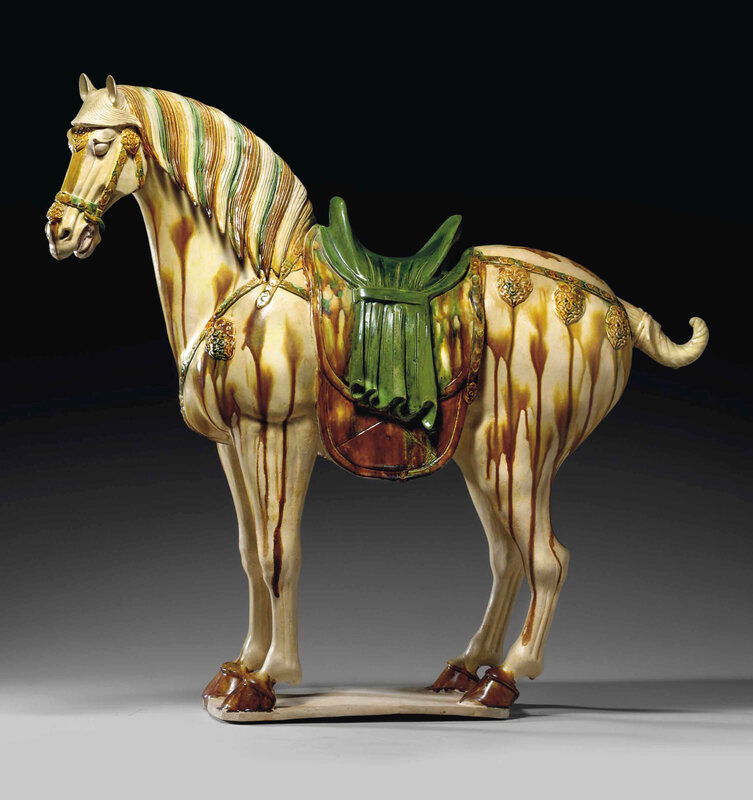A large and finely modeled sancai-glazed pottery figure of a Ferghana horse, Tang dynasty (AD 618-907)
Lot 2071. A large and finely modeled sancai-glazed pottery figure of a Ferghana horse, Tang dynasty (AD 618-907); 28 in. (71 cm.) high. Estimate USD 200,000 - USD 300,000. Price Realized USD 365,000. © Christie's Images Ltd 2014.
The horse is shown standing foursquare on a rectangular plinth with its head turned slightly to the left and mouth open. Its striated forelock is swept back beneath the pricked ears and the long segmented mane, attractively glazed in streaks of green, amber and cream accentuating the combed sections, is tossed to the left side of the powerful neck. The green-glazed saddle is set on a contrasting splash-glazed blanket, and the trappings are molded with florets and hung with 'apricot' leaf medallions handsomely covered in amber and bright green glazes. The muscular, straw-glazed body is handsomely dappled with controlled splashes of amber that drain onto the neck and legs.
Provenance: Acquired in the United States, January 1999.
Note: This large and elegantly proportioned horse embodies the power of this celebrated animal. The most magnificent breed, immortalized in Chinese literature and the visual arts, was the Ferghana horse, introduced into central China from the West during the Han dynasty (206 BC-AD 220). These were the fabled 'celestial' or 'blood-sweating' horses, known for their speed, power, and stamina. The renowned court artist Han Gan (720-60) changed the nature of Chinese horse painting when he depicted one of Emperor Xuanzong's (r. 847-59) favorite horses, Night-Shining White (now in the collection of the Metropolitan Museum of Art), in a realistic rather than supernatural manner. This development parallels the realism of Tang arts in general, and is exemplified by this magnificent horse.
The most unusual feature of the horse is its stylish mane, combed into pointed locks of three alternating colors. This effect was difficult to achieve, given the tendency of sancai glazes to run. A very similar horse with a combed mane of alternating colors is illustrated in Mayuyama, Seventy Years, vol. I, Tokyo, 1976, no. 202, and also illustrated in Zhongguo taoci daxi: Han Tang taoci daquan, Taipei, 1987-89, p. 224.
The result of Oxford Authentication Ltd. thermoluminescence test no. C102b82 is consistent with the dating of this lot
Christie's. Fine Chinese Ceramics and Works of Art, New York, 20 - 21 March 2014

/https%3A%2F%2Fprofilepics.canalblog.com%2Fprofilepics%2F1%2F0%2F100183.jpg)
/https%3A%2F%2Fstorage.canalblog.com%2F03%2F02%2F119589%2F96711876_o.jpg)
/https%3A%2F%2Fstorage.canalblog.com%2F11%2F31%2F119589%2F94773502_o.jpg)
/https%3A%2F%2Fstorage.canalblog.com%2F20%2F83%2F119589%2F94772815_o.jpg)
/https%3A%2F%2Fstorage.canalblog.com%2F26%2F72%2F119589%2F75604929_o.jpg)
/https%3A%2F%2Fstorage.canalblog.com%2F59%2F60%2F119589%2F26458628_o.jpg)



/http%3A%2F%2Fstorage.canalblog.com%2F85%2F43%2F119589%2F129846067_o.jpg)
/image%2F1371349%2F20240309%2Fob_21f58a_getcollectionimage-13.jpg)
/image%2F1371349%2F20240309%2Fob_325ca4_getcollectionimage-3.jpg)
/http%3A%2F%2Fstorage.canalblog.com%2F02%2F27%2F119589%2F129759780_o.jpg)